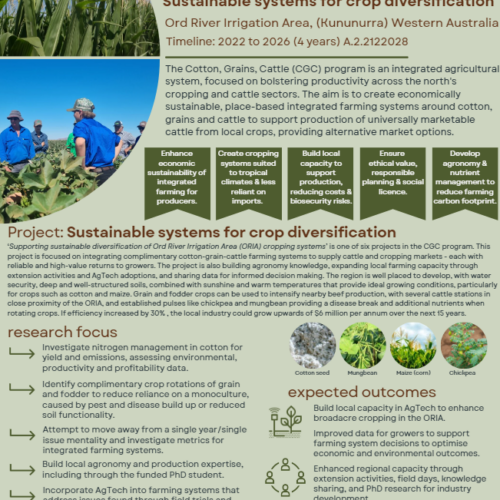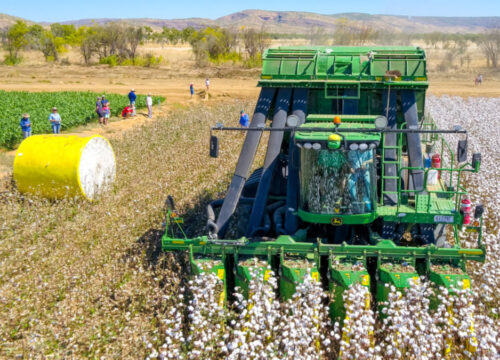
- Author CRCNA
- Publish date 18 July 2024
- Type Fact sheet
- Documents
- Cotton Grains Cattle program
- Agriculture
- Beef
- Broadacre cropping
Summary
‘Supporting sustainable diversification of Ord River Irrigation Area (ORIA) cropping systems’ is one of six projects in the Cotton, Grains, Cattle (CGC) program. This project is focused on integrating complimentary cotton-grain-cattle farming systems to supply cattle and cropping markets – each with reliable and high-value returns to growers. The project is also building agronomy knowledge, expanding local farming capacity through extension activities and AgTech adoptions, and sharing data for informed decision making. The region is well placed to develop, with water security, deep and well-structured soils, combined with sunshine and warm temperatures that provide ideal growing conditions, particularly for crops such as cotton and maize. Grain and fodder crops can be used to intensify nearby beef production, with several cattle stations in close proximity of the ORIA, and established pulses like chickpea and mungbean providing a disease break and additional nutrients when rotating crops. If efficiency increased by 30% , the local industry could grow upwards of $6 million per annum over the next 15 years.
Projects
Cotton Grain Cattle program: Supporting sustainable diversification of ORIA cropping systems
This project is part of the CRCNA’s integrated farming systems – Cotton, Grains and Cattle program. The Ord River Irrigation Area (ORIA) lays claim to the highest water security in Australia, thanks to the immense water storage from Lake Argyle. The high level of water security, deep and well-structured soils, combined with sunshine and warm temperatures provide ideal growing conditions, particularly for crops such as cotton and maize. During the past 5 years of research, planting cotton in the wet season has consistently demonstrated high yields. This is due to flowering occurring during the optimal early dry season periods of March through to May. Previous to Bollgard 3 (BG3) technology, this flowering window would be at high risk from Lepidoptera pest damage, which has previously held back a northern cotton industry. The success of the cotton crop agronomically, as well as supplying two commodity markets, each with reliable high-value returns to growers, provides an opportunity to establish an integrated cotton-grain-cattle farming system whereby each component compliments the other. This project aims to move away from a single year/single issue mentality and investigate several metrics in an integrated farming system. The primary issues to be addressed include identifying suitable rotations with cotton and maize, optimising N inputs, incorporating Ag Tech into a farming system, building local skills and expertise, and inclusion of a PhD student. Nitrogen management in cotton is to be investigated as this has implications for productivity, profitability, and the environment. Crop N availability is key driver of crop yield, but N is also the largest contributor of GHG emissions from a cotton crop. The project will also building local capacity through the adoption of Ag Tech in the cotton/grain system. It is anticipated that adoption of this technology will enhance broadacre cropping in the ORIA. A focus of this project will be to look at potential technologies that can be validated or demonstrated to either enhance trials being conducted and/or address systems issues identified through engagement. In addition to boosting local skills and capacity in the farming community through extension of knowledge and lessons gained from the project onto the local farming community to, an important part of this project will be supporting a PhD candidate to undertake some of the R&D required. While to be based at The University of Queensland, in southern Queensland, all field work will occur in Kununurra and the knowledge gained will be directly applicable to cropping in the ORIA.


